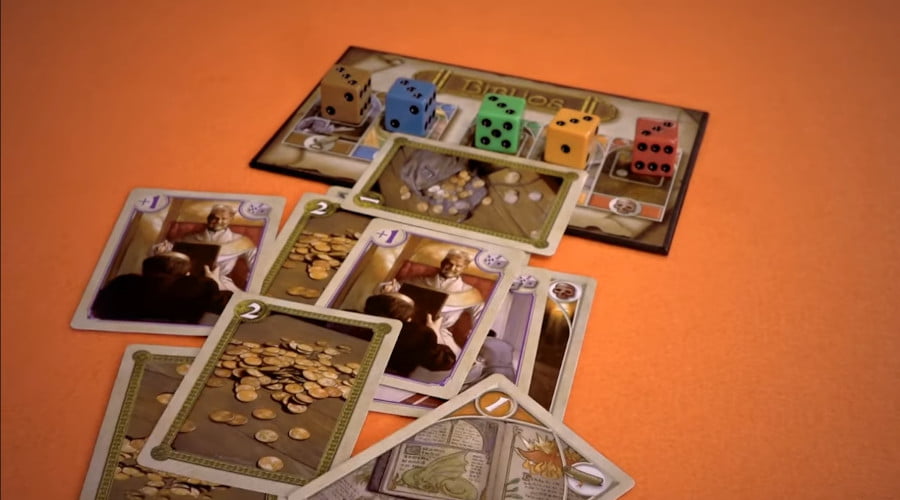I like watching board game reviews. Part of why I like watching them is because they often rely on telling you how a mechanic works in a broad sense but never the refined ways that design interacts with all the pieces. Just recently I watched a review from Shut Up And Sit Down for Steve Finn’s Biblios (the one that’s not in print) and got treated to this beautiful brain-expander of a board design:
The idea presented in the review is there are cards that affect public information, and this central card with the dice on them is used to represent that public information. You can do things that may make say, the green dice ‘worth more’ so it dials up. Or you may do something to depress the market for yellow dice things and reduce the value of that dice. I don’t know, I’ve never played Biblios.
I know that in this case no matter what, you don’t want to roll these dice. Despite them being dice that you can roll, the game looks to me to be more interesting if these are reliable trackers. Their utility as dice may mean that we can do things like swap out dice of whole types, or maybe do a dice drafting thing to set up, but once they’re set in place, that seems cruel.
What stands out to me is the way that just looking at this simple tableau gives me ideas for things that I think I may want to do that are attainable within Gamecrafter levels of cost:
Single Set, Public Information
Okay, first of all there’s how Biblios has it. These can be used for a changing, interactive market; on my turn, I play some cards that do things to that market. Things go up and down depending on their slot, and that means on my turn, I may do things that make your turn worse.
Could be done with simultaneous turns as well — we call play some cards out and they affect the dice, ratcheting up and down. My play could mess with yours. In this case I like the idea of giving every card a priority number, so there’s a fixed value on what does or doesn’t happen.
Multiple Sets, Public Information
These dice can be used to track certain things in your own pool. They could be little towns, with each dice type representing a thing you have in your town or a project in progress. Could even make it so there are optional or exclusive places for dice – if you have a wizard tower, you can’t have a warrior’s guild, that kinda thing.
This could be a great idea for a builder game. Heck, I saw a mechanic for lanes recently – maybe this could be used to represent bases sending attackers at one another, the numbers of the dice being both your health and your strength. Or maybe even take the Quantum route, where the dice faces have a push-pull factor.
In Quantum, your ships are represented by dice; the value represents a sort of armour save. If you shoot at a ship, you have to roll a number higher than the number on the dice to destroy it. By contrast, ships move 6 squares, minus the number on them – meaning that 1s are zippy and fast moving, like the road runner, but also die hilariously easily, like the Wile E Coyote. You could set a game so that you have a number of units configured with dice in front of you, but the cards you play let you ‘act’ on that.
Multiple Sets, Private Information
This is where the game rules get really complicated, because hiding information that can be easily mixed up or mistracked (like if you bump a dice) runs the risk of making the game more complicated or difficult, or reducing trust between players. That’s not ideal, I don’t want to do that. When you use screens for things I tend to like it to be for entirely discrete things – you either have them or you don’t, and the state of them when they went into hiding doesn’t matter. Cards and currencies work well for this, dice faces less so.
